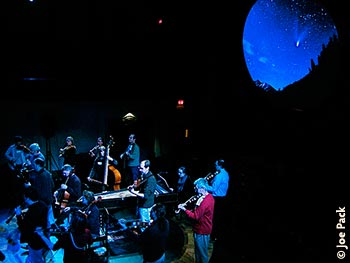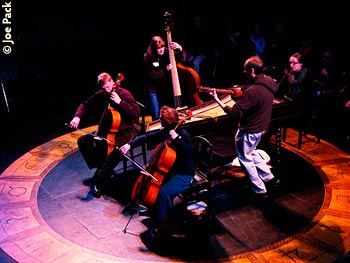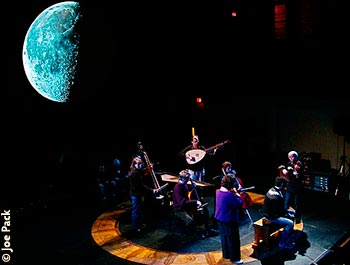 |
Tafelmusik Baroque Orchestra
The Galileo Project: Music of the Spheres |
|
| January 21, 2009 • Trinity-St. Paul's Centre • Toronto |
|
|
|
|
|
|
| Report by Jessica Lombardi with photos by Joe Pack |
| Tafelmusik's extraordinary commitment to Baroque performance practices is evidenced by their thoughtful concert presentations and masterful performances of period pieces. Alison MacKay, the orchestra's violone and double-bass player, was the artistic planner behind The Galileo Project: Music of the Spheres, a concert program that is allied with Tafelmusik's recent initiatives to try and reconnect audiences with the music they study and perform on a higher level of understanding. Also, in accordance with the International Year of Astronomy 2009, this concert program highlighted some of the major figures and accomplishments in the areas of astronomy and music in early 17th-century Europe. After a year of brainstorming and rehearsing, the orchestra, along with many professionals in a variety of scientific and artistic disciplines, rendered an inspiring performance with long-lasting effects. |
| The world we live in is wonderfully enriched by the sensitive arts and the genius ideas that we invent, discuss, and ultimately strive to express through performance and/or demonstration. A major driving force behind invention is the desire to express some brand of truth in order to help redefine our perception of the world and restore a sense of hope for the future. In his lifetime, Galileo Galilei was examining the natural world in pursuit of some clue to the whole mystery of the cosmos, searching for truth far beyond the borders of optical perception. This concert remembered the influences of the Galilei family in various spheres of society: Galileo, his father Vincenzo, his brother Michelangelo, and many friends and associates of the family all played an important role in defining that boundary of time that marked the beginning of the Baroque in European history. (For example, a description of Vincenzo's experiments with lute strings and the expressive power of solo-song was included in the concert guide provided and the concert repertoire did feature a beautiful Toccata for solo lute by Michelangelo).
The evening's program-guide was an insightful read, providing an in-depth look behind the scenes of The Galileo Project, as well as describing many of the connections between musical invention and scientific discovery and offering good explanations for the concert's repertoire. In the Baroque era, a new system for tuning instruments was developed with the aid of scientific inquiry, which ultimately formed the basis of Western tonality in the classical tradition of music. Also, there were great innovations and improvements made to musical instruments and new techniques employed in composition.
Greatly influencing culture and society for everyone, the unveiling of the cosmos was no doubt a great force behind the period's flourishing arts movement. The evening's production incorporated a well-chosen repertoire of great 17th-century composers augmented by astronomical photographs and animated films — which were projected onto a 12-foot high round screen — and brought to life the ideas that were presented from historical texts and literature; the correspondence and journal entries of Galileo's own hand, as well as memoirs of Galileo written by his son. As the concert panned out, the audience was taken on a journey across the universe and into the world where these great thinkers and artists lived and worked.
|
|
|
|
| Reflective compositions, dynamic performances, and extraordinary backdrops inspired great wonder and a good dose of truth through history and art. The character of the music continuously affected the audience’s experience of the story-line: for the Passacaglia by Biagio Marini, the musicians moved into the aisles and surrounded the audience while the instruments wept for Galileo's misfortunes; however, then Monteverdi's Moresca, from Orfeo — the first 'real' opera ever composed — turned up our spirits with the musicians dancing and stamping their feet to up-beat rhythms emphasized by festive drums and tambourines. The memory work of the musicians made the concert all the more impressive and relatable, and it was clear by their interactions with one another, their physical movements and expressions, that the musicians were themselves inspired by the concert.
Music of the Spheres, the subtitle of the concert, came from the astronomer/ mathematician Johannes Kepler, specifically from his Harmonices Mundi (The Harmony of the Worlds), where he derived melodic fragments for each of the planets from formulas about the laws of planetary motion. His themes — drastically distinct from one another in their nature (i.e. in instrumental timbre, rhythm, key, duration, etc.) — were demonstrated by the orchestra and then followed by a performance of J.S. Bach's chorale tune Wie Schön Leuchtet die Morgenstern (How Brightly Shines the Morning Star), which interwove these melodies within the composition, and served as a stellar conclusion to the evening's performance.
This multi-disciplinary event, put on by these visionary leaders of our time, showed a lot of potential to inspire people of all ages on a global and a personal level, for they inspired their audience to contemplate some of life's greatest mysteries by displaying its greatest discoveries. People may not typically look to this music for new ideas, but with the increased interest in multi-media and multi-disciplinary art, the traditional style here can be seen through a new lens.
|
|
|
|
|
|
|





